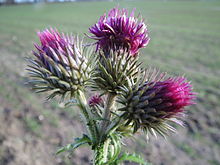Carduus acanthoides, known as the spiny plumeless thistle, welted thistle, or plumeless thistle, is a biennial plant species of thistle in the family Asteraceae. The plant is native to Europe and Asia and introduced in many other areas, where it is sometimes considered an invasive species.
| Carduus acanthoides | |
|---|---|

| |
| Carduus acanthoides flower heads | |
| Scientific classification | |
| Kingdom: | Plantae |
| Clade: | Tracheophytes |
| Clade: | Angiosperms |
| Clade: | Eudicots |
| Clade: | Asterids |
| Order: | Asterales |
| Family: | Asteraceae |
| Genus: | Carduus |
| Species: | C. acanthoides
|
| Binomial name | |
| Carduus acanthoides | |
Description edit
Carduus acanthoides may exceed 2 metres (6.6 ft) in height and can form weedy monotypic stands. The stem and foliage are spiny and sometimes woolly. The specific epithet acanthoides refers to its spiny foliage.[1] The plant starts from a flat, basal rosette and then bolts an erect stem with occasional toothed, wrinkled, spiny leaves.[2] The leaves are 4–8 in (10–20 cm) long with lobed or pinnately-divided edges.[3][1] The abaxial surface (underside) of the leaf is somewhat hairy.[4]
At the top of each branch of the stem is an inflorescence of one to several flower heads, each rounded, covered in spiny phyllaries, and bearing many threadlike, purple or pink disc florets. Each flowerhead is around 0.5–1 in (13–25 mm) across.[1] It flowers throughout the summer and early fall.[4] The achenes are 2–3 mm long, four-angled, with faint lengthwise stripes. The fluffy pappus bristles are 11–13 mm long.[5] After flowering and setting seed, it dies.[1]
Distribution and habitat edit
Carduus acanthoides is native from France, Italy, and western Turkey; through Russia and Kazakhstan; to China.[6] In its native range the plant is found in open grasslands and disturbed areas, and in non-native ranges it is a weed of annual grasslands, roadsides, fields and pastures, and disturbed areas.
The plant has introduced broadly across much of North America where it is sometimes considered a noxious weed or invasive species.[5][2][7] The California Department of Food and Agriculture has an active program to control known populations.[2] It spreads through its seeds. Each plant creates around 1,000 seeds.[8] However, the plant has beneficial impacts on the native bees in North America.[9]
Although first noted in 1962 in the Chicago region, it has not been seen since 1985.[4] In Michigan and Wisconsin, it does not occur in remnant, native habitats, but rather those with a history of disturbance, such as railroad right-of-ways, roadsides, and farm fields.[10][1]
References edit
- ^ a b c d e "Online Virtual Flora of Wisconsin - Carduus acanthoides". wisflora.herbarium.wisc.edu. Retrieved 5 January 2020.
- ^ a b c Cal-IPC (California Invasive Plants Council) — Carduus acanthoides (plumeless thistle) . accessed 4.8.2013
- ^ "Exotic Species: Spiny Plumeless Thistle (U.S. National Park Service)". www.nps.gov. Retrieved 2016-09-14.
- ^ a b c Wilhelm, Gerould; Rericha, Laura (2017). Flora of the Chicago Region: A Floristic and Ecological Synthesis. Indiana Academy of Sciences.
- ^ a b Jepson Manual Treatment of Carduus acanthoides
- ^ "Carduus acanthoides". Germplasm Resources Information Network. Agricultural Research Service, United States Department of Agriculture. Retrieved 16 January 2018.
- ^ "Plants Profile for Carduus acanthoides (spiny plumeless thistle)". plants.usda.gov. Retrieved 2016-11-07.
- ^ Rauschert, Emily S. J.; Shea, Katriona; Goslee, Sarah (2015-01-01). "Plant community associations of two invasive thistles". AoB Plants. 7: plv065. doi:10.1093/aobpla/plv065. ISSN 2041-2851. PMC 4571105. PMID 26038126.
- ^ Russo, Laura; Nichol, Christina; Shea, Katriona (2016). "Pollinator floral provisioning by a plant invader: quantifying beneficial effects of detrimental species". Diversity and Distributions. 22 (1/2): 189–198. doi:10.1111/ddi.12397. ISSN 1366-9516. JSTOR 24817466. S2CID 86411284. Retrieved 26 August 2022.
- ^ Reznicek, A. A.; Voss, E. G.; Walters, B. S., eds. (February 2011). "Carduus acanthoides". Michigan Flora Online. University of Michigan Herbarium. Retrieved 5 January 2020.